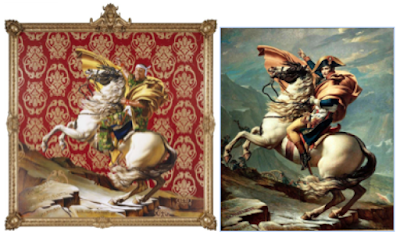I
have always enjoyed Impressionism. As a child, I was drawn to the bright colors
and seemingly random scatter that somehow became a coherent image from far
away. As I’ve grown up and frequented art museums, I have also come to admire
the perseverance of the Impressionist artists in the face of rejection from the
Salon and popular culture, and their confidence in themselves. I have always
loved Monet, who I heard about a lot at art auctions my parents would attend,
or Degas, whose paintings hung in my ballet studios growing up. I wanted to
learn more about a less familiar Impressionist artist, so I chose Camille
Pissarro, after a bit of preliminary research.
I
primarily used John Rewald’s book “Camille Pissarro” in my research, which I
selected randomly; I later discovered Rewald is quite a respected art
historian. Rewald calls Pissarro the “dean of Impressionist painters…by virtue
of his wisdom and his balanced, kind, and warmhearted personality”. Pissarro
was born in 1830 on St. Thomas (Danish nationality), making him the oldest of
the group of Impressionist painters. As Rewald writes, Pissarro meets Monet in
London through Paul Durand-Ruel who is a pivotal Impressionist art dealer. With
Monet, he studied English landscapes and learned a “looser technique and
greater lightness of color” (14). During this time, “neither he nor his comrades [Monet,
Renoir, Sisley, Cezanne, Degas] succeeded in having their works accepted by the
jury of the Salon, which scorned their bright colors, their unconventional
technique and their lack of rigid contours”. (15)

“Two Women Chatting by the
Sea” was painted in 1856, and depicts an image from St. Thomas. As one of
Pissarro’s earlier works, he was influenced by Danish artist Fritz Melbye who
lived on St. Thomas and guided Pissarro. He first developed his love of art
when he was sent to boarding school at age 12 in Paris, but was persuaded into
becoming a full-time artist by Melbye. This was painted one of the last times
he was home in St. Thomas, before permanently moving away.

“The Garden of Les Mathurins
at Pontoise” was finished in 1876. This painting is noted for being one of the
first to definitively divide color.

Pont Boieldieu in Rouen,
Rainy Weather was
painted in 1896. This painting, painted in Pissarro’s later years, shows his
move away from only painting traditional landscapes, and transition to also
painting the movement of cities. Pissarro himself describes this painting: “The
theme is the bridge near the Placede la Bourse with the effects of rain, crowds
of people coming and going, smoke from the boats, quays with cranes, workers in
the foreground, and all this in grey colors glistening in the rain…what
particularly interests me is the motif off the iron bridge in wet weather with
all the vehicles, pedestrians, workers on the embankment, boats, smoke, haze in
the distance; it's so spirited, so alive.” Pissarro painted this from inside
the Hotel de Paris in Rouen, where his room overlooked this view. He started
having eye trouble and thus, difficulty painting out in the open in the 1890s,
so this was likely the reason he painted this from behind a closed window.
However, as obvious, his work does not show any of these eye troubles; in fact,
according to Rewald, “Pissarro himself considered some of his last works the
best he had ever done” (18).
Sources
Rewald, John.
“Camille Pissarro”. London: Thames and Hudson, 1991.
Group blog of
Art History students at the Barstow School, http://my-kid-could-paint-that.blogspot.com/2012/02/garden-of-les-mathurins-at-pontoise.html
Bernier, Ronald. Monument,
moment, and memory: Monet's cathedral in fin de siècle France Bucknell
University Press, 2007. pg. 36
Art Gallery of Ontario:
Selected Works. Art
Gallery of Ontario, 1990 pg. 143









